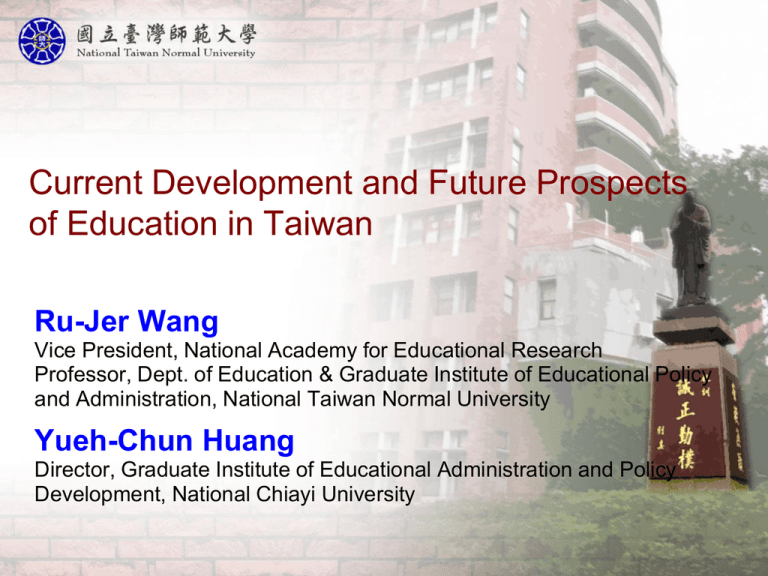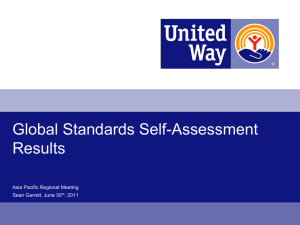Current Development and Future Prospects of Education in Taiwan
advertisement

Current Development and Future Prospects of Education in Taiwan Ru-Jer Wang Vice President, National Academy for Educational Research Professor, Dept. of Education & Graduate Institute of Educational Policy and Administration, National Taiwan Normal University Yueh-Chun Huang Director, Graduate Institute of Educational Administration and Policy Development, National Chiayi University Structure 1 The current development of education in Taiwan 2 The future prospects of education in Taiwan 1. The current development of education in Taiwan 1 Educational expenditure 2 Percentage of the students completing post secondary education 3 Enrolment rate of higher education 4 Unemployment rates of different educational levels 5 Percentage of the cost of R&D funds accounting in GDP (1) Educational expenditure • Percentage of the investment in education: The highest one was 6.88% in 1993; while the lowest was 5.39% in 2000. • After the first time of party alternation in power between 2000 to 2008, the figures were all below 6%; while after the second time, the figure rose up to 6.51% in 2009. 6.88% 5.39% Figure 1 Educational expenditure from 1993- 2009 accounting in GDP Sources from: Department of Statistics (2010). (2) Percentage of the students completing post secondary education • Nowadays, the educational background of most youngsters in Taiwan has reached more than high school level. • The percentage of the students completing post secondary education in different years: The highest was 89.5% in 2009; whereas the lowest was 73.2% in 2000. 89.5% 73.2% Figure 2 The percentage of the students age 20-24 who (at least) completing late secondary educations from 2001-2009. Sources from: National Statistics, R.O.C. (2010a) (3) Enrolment rate of higher education • Higher education in Taiwan has developed rapidly in the past decades, also changes the traditional views- from elite education to popularized education. Table 1. The enrolment rates (general enrolment) of Tertiary Education (age 18-21) unit: % Sources from: Department of Statistics (2007a). Note 1) General enrolment: the number of tertiary students / the number of people at the school age x 100 2) From 2004, the general enrolment rate of tertiary education excludes the students of graduate schools and training schools. (4) Unemployment rates of different educational levels • The unemployment rates are different among people with different educational backgrounds. • The unemployment rate of those with the compulsory education level is comparatively the lowest (4.88%), that of secondary education level is 5.63% and the ones with college level is 5.17%. Table 2. Unemployment in 2010 (divided through educational levels) Sources from: National Statistics, R.O.C. (2010b). (5) Percentage of R&D expenditure accounting in GDP • The figure appears to getting higher from the first time political parties alternation of power in 2000. The same situation is also found on the second time in 2008. Figure 3 The percentage of the cost of all R&D funds accounting in GDP from 2000-2009 Sources from: NSCNT (2010). As shown above, the educational popularization in Taiwan is obvious and rises considerably in recent decade, the investment on research as well. However, the investment on education has decreased for a long time. 2. The future prospects of education in Taiwan (1) Primary and secondary education- planning a 12 years citizen education Law: Is 12 year citizen education a compulsory education? If so, the government should enact related laws and provide each student the same opportunity to attend schools. Expenditure: Is 12 year citizen education a free education? If so, the government is responsible for offering free education to each student. Enrolment: Is 12 year citizen education a free admission education? If so, there will be no extra exam. Students usually choose schools by their neighboring residential areas. School type: Is 12 year citizen education a same-school-type education? If so, students all enter the same type of school, and diversified education will no long exist. Year length (international comparison): Compared to the school year length in Taiwan(12 years), the following data are different among countries. Table4. Countries of 9 year (or above) education policy Table5. Countries of 10 year (or above) education policy 2. Higher education-popularization vs. decreasing birth rate The fast expansion of higher education in Taiwan has changed the traditional view on education. However, the decreasing birth rate becomes a new problem. The potential number of students will diminish and what’s the worse, there will be a terrible lack of professionals and industry in Taiwan may thus confront a huge shock. decreased over hundred thousand Figure 4. the number of tertiary school students is under the hypothesis that 96% graduates from high school all continue to study in university. Sources from: Department of Statistics (2007b). The trend of the development of higher education in Taiwan --Facing the decrease of birth rate The number of faculty with PhD in Taiwan has been rising over past years, which shows that Taiwan has well quality teachers. if Taiwan’s government could set up attractive educational policies and offer incentives (such as scholarship, Chinese learning), this will be beneficial for raising Taiwan’s international status, creating higher GDP, and improving economic effectiveness. Hence, Table 6. Academic background of university faulty in Taiwan Sources from: Department of Statistics (2007a). unit: % “Part-time learning” & “Credit Accumulated/Transferred and Register System” “Part-time learning” in higher education not only increases the number of potential students, but also provides ample opportunities for young students and adults to interact with each other. The employment rate of the former will thus be positively affected. Credit accumulated/transferred and register system: Opportunity for adult learners should be given; Universities should amend their recruitment strategies and increase a variety of students from different background; A cross-school (either national or international) system and its relevant measures are also required; Credit accumulated/transferred and register system in each lifelong learning institution should be found.






